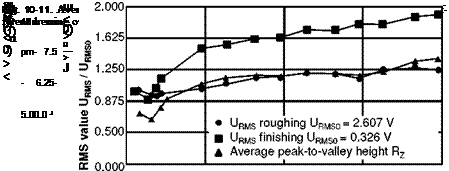10.6.1 Monitoring Grinding Wheel Wear with the AE Effective Value
The AE effective value depends to a great extent on the specific material removal rate Q’w, the dressing conditions and the grinding wheel specifications as well. Likewise, the level of the URMS-value in the individual process phases correlates with the effective peak-to-valley height of the grinding wheel and thus with average peak-to-valley height of the workpiece [BAUS03, DORN84, INAS77, KOEN89, MALK84, MEYE91, SAXL97].
This is shown in Fig. 10-11 on the basis of the influence of the dressing overlap ratio Ud on the behaviour of the average peak-to-valley height Rz throughout the service life. For the dressing overlap ratio of Ud = 10 selected for the experiment, the disc wears from micro-breakage of the cutting edges such that workpiece roughness increases on average. The level of the effective value of the AE changes in the same manner, as the lower part of the illustration shows. It is here a case of the static average value of the signal in the respective process area. The image includes the level trajectories of the URMS-value for the roughing and finishing areas. Slightly varying URMS-paths result. The degressive path of the averaged peak-to — valley height between V’w = 60 — 450 mm3/mm is reproduced better in the AE — signal of the finishing phase, since this phase determines the target workpiece roughness for the most part. Tendentially however, both URMS-curves reliably indicate the changing effective peak-to-valley height of the tool throughout the service life [KOEN91, MEYE91].
|
Process control |
3-stage |
|
Grinding wheel |
AA 60 J4 V15 |
|
Material |
100 Cr 6; 63 HRC |
|
Grinding wheel circumferential speed |
vs = 45 m/s |
|
Workpiece speed |
vw= 0.7 m/s |
|
Spec. material removal rate |
Q‘w = 3.0 mm3 /mms |
|
Dressing overlap ratio : |
Ud= 10 |
|
Cooling lubricant |
emulsion (3 %) |
 |
